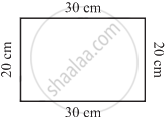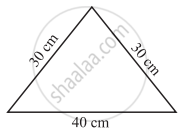Advertisements
Advertisements
Question
Rahim and Peter go for a morning walk, Rahim walks around a square path of side 50 m and Peter walks around a rectangular path with length 40 m and breadth 30 m. If both of them walk 2 rounds each, who covers more distance and by how much?
Solution
Perimeter of the square = (4 × side) units
Side of the square = 50 m
∴ Perimeter = 4 × 50 m = 200 m
Rahim walked twice around the park
∴ Total distance walked by Rahim = 2 × 200 m
Total distance covered by Rahim = 400 m
Perimeter of a rectangle = 2(length + breadth) unit
Length = 40 m
Breadth = 30 m
∴ Perimeter = 2 × (40 + 30) m
= (2 × 70) m
= 140 m
Peter walked around twice
∴ Distance covered by Peter = 2 × 140 m
= 280 m
∴ Distance covered by Peter = 280 m
400 m > 280 m
Difference = 480 – 280
= 120 m
∴ Rahim covers 120 m more than Peter
APPEARS IN
RELATED QUESTIONS
The diagonal of a rectangle is 34 cm. If its breadth is 16 cm; find its :
(i) length
(ii) area
Find the perimeter of a regular hexagon of side 6.5 cm.
If A denotes area of a rectangle, l represents its length and b represents its breadth, find:
l, if A = 48 cm² and b = 6 cm
A rectangular piece of paper has area = 24 cm² and length = 5 cm. Find its perimeter.
The perimeter of a square plot = 360 m. Find:
- its area.
- cost of fencing its boundary at the rate of ₹ 40 per meter.
- cost of levelling the plot at ₹60 per square meter.
Sanju completes 12 rounds around a square park every day. If one side of the park is 120 m, find out in kilometres and metres the distance that Sanju covers daily.
How many different rectangles can be made with a 48 cm long string? Find the possible pairs of length and breadth of the rectangles.
Length and breadth of a rectangular sheet of paper are 20 cm and 10 cm, respectively. A rectangular piece is cut from the sheet as shown in figure. Which of the following statements is correct for the remaining sheet?
The area of a rectangular field is 1600 sq m. If the length of the field is 80 m, find the perimeter of the field.
What is the perimeter of the following figures? What do you infer from the answers?
 (a) |
 (c) |
 (b) |
 (d) |
